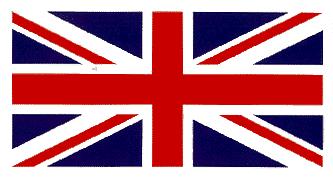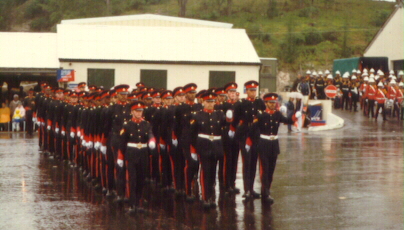

VARIOUS PHOTOGRAPHS
This meant changes were in store even for the military units left in Bermuda. Briefly run on a skeleton structure, the BVRC, re-titled simply the Bermuda rifles, was re-organized in the late '40s. Bigger changes were in store however. With the closure of the HM Dockyard ( but for a small supply and fuelling base, HMS Malabar, which continued 'til 1995,) there was no longer a need for a military garrison to protect it. The Regular Army detachment was removed in 1953 and Prospect Camp, together with most of the MOD lands, were returned to the civil authority.
The Imperial Defence Plans were also scrapped, and from that point the terretorials ceased to have any tasking under the War Office/Ministry of Defence. In fact, the UK Government withdrew all funding it had still been supplying towards the maintainence of these units. Despite its original reluctance at creating volunteer units, the Colonial Parliament decided to continue the two units, bereft of role, entirely at its own expense.
This led to a conundrum, thanks to the racial divisons still extant in the colonies militia, and throughout the larger society. With the withdrawal of the Garrison, the last 6" Coastal Artillery pieces were rendered in-operable. They were very long in the tooth, by that point, and largely redundant, anyway, in a world of aeroplanes and missiles. This meant continuing the BMA as an artillery unit was not possible. As there was no willingness to allow Blacks to enlist in the Rifles, de-mobbing the BMA would have meant more than half the colony's manpower would have been wasted as a defense asset. Either a new Black infantry regiment would have to be created or the BMA would have to convert to that role. The latter course was chosen. In 1953 the BMA were re-equyipped and trained as infantry. This caused some disquiet as the gunners felt some romantic connection to their guns, and worried that their position as the senior regiment (the Royal Regiment of Artillery, with its constituent elements, is the oldest regiment of the British Army and takes precedence over all infantry and other units on parades or lists) was in jeopardy. However, though now an infantry unit, they retained Royal Artillery title, uniform and badge.
The units would continue to have a role to protect the island, in co-operation with the US forces stationed there, then, in the event of any new war involving NATO, though they had no tasking under that organization either. They were also tasked with a potential Internal Security function, one which looked ever more useful as the racial segregation began to be challenged ever more agressively with the approach of the 'sixties.
By the early 'sixties, in fact, the racial segregation of the military was no longer viable. The un-neccessary duplication of assetts probably didn't enter at all into the decision to merge the two units into a single regiment. This was affected through the Defence Act of 1965. The two units had already begun combining for ceremonial functions and, in 1965, they were amalgamated to form the Bermuda Regiment. This unit was meant to carry on the histories and some of the characters of each of the donor units. Although it doesn't wear the battle honours on its badge or colours, it is presumably entitled to the awards the BVRC won in the Great War (this would have been complicated as the BMA, as an artillery unit, did not have any battle honours do primarily to the peculiar way in which the greater RRA handles these awards-naming sub-units for each award. Some might say it has a universal award in its motto, 'ubique'-'everywhere'. In any case, the BMA not bringing any awards, it was probably decided to elide those of the BVRC).
The bi-metal cap badge of the Bermuda Regiment combines a brass field gun with a white metal Maltese Cross set inside the over-large wheel, with a half wreath under and a half-banner above carrying the word 'Bermuda', surmounted by a crown. The Maltese Cross is the symbol of rifle units within the British Army, and was the central component of the BVRC badge.
The dress uniform is a particular curiosity being (except for the standard-issue white tropical tunics worn in Summer,) unique to the Bermuda Regiment. Dark blue trousers with a broad red stripe down the outside of each leg are fairly generic, but the dark blue tunic, unlike the Royal Artillery tunic that had been worn by the BMA, or the modern general-pattern tunic blue tunic worn by most British Army regiments, has a red collar and cuffs (and some might say, is not very well-made!) A general-pattern, dark blue peaked cap with red band is worn. Having no trace of the BVRC's rifle-green uniform and Bblack busby, this dress uniform has not changed since the unit's inception in 1965. The combat uniform inheritted from the earlier units would have been khaki battledress, Dennison parachute smock (doubtless owed to some veteran returning from the Parachute Regiment at the end of the Second World War,) and '37 and '58 Pattern webbing. Second World War pattern green tropical uniforms, made in Hong Kong, were used in the Summer months, together with an eclectic mixture of cotton battle and barracks dress. By the mid eighties the Battle dress had gone, along with ankle boots, anklets and puttees. The Dennison smock was replaced with the '68 Pattern Combat Jacket, green lightweights and pullovers were worn under and DPM tropical uniforms began to appear in the Rifle Companies. The '58 Pattern webbing soldiersd on, only being replaced in the new millenia with DPM PLCE.
The slow adoption of new kit, and the occassional inferiority of that kit, is something the Bermuda Regiment has hads in common with UK TA units, but is also symtomatic of the colony's decision to go it alone in funding the units. The colonial parliament puts a rather low priority on funding the unit and from the 'sixties this has meant the desire to stick with British standard equipment has begun to be sacrificed to economy. The first and most critical sign of this has been in firearms. In earlier ages the Colonial Government could depend on the War Office to either subsidize, or outright give, equipment. Hence, the first machine Gun taken on strength by the BVRC in the 19th Century-a Maxim-was simply handed over by Prospect. With the patriotism raised by the Great War, however, the Colonial Government had begun to take an increasing hand in the voluntary funding of the units, paying 250 pounds, apiece, for Vickers Guns in 1915. When new type of .303'ammunition was adopted shortly after, however, requiring the replacement of SMLE rifles chambered for the earlier versions of the round, the Colonial Government was able to acquire new rifles at very reasonable cost due to allowances made by the War Office.
Very quickly in the Second World War, too, new battledress uniforms and webbing, and new weapons appeared in the hands of the local units. At the war's start, the infantry used the SMLE rifle, the Lewis and Vickers light and heavy machine guns. By War's end, the No.4 rifle, Bren light machine gun and the Sten sub-machine gun had all appeared.
When it came time to replace these .303" weapons with the new NATO calibred weapons in the 'sixties, however, the Bermuda Regiment could not count on the subsidy of a MOD that thought it excess to needs. Consequently, when it bought L1A1 rifles, they came from Canada and Australia, and the General Purpose Machine Guns which replaced its Brens and Vickers are actually the Belgian-made, metric-dimensioned MAG58, rather than the superficially-similar, inch-dimensioned L7A1 built under licence in England.
Although there are numbers of Sterling sub-machine guns in the Bermuda Regiment's armoury, the weapon issued to drivers, medics and other secon-tier troops is the Israeli Uzi. A complete break was made with the standard British infantry weapon-the rifle- in the 'eighties when the L1A1 SLR was replaced, not with the SA80 ( still lost in interminable development Hell, at that point,) but the American Ruger Mini-14. This 5.56mm rifle, effectively scaled down from the same design the USA fought the Second World War with, was originally intended for sporting use, and despite being retro-fit with a black, plastic Choate stock ( which ruins its
CONTINUED OVER